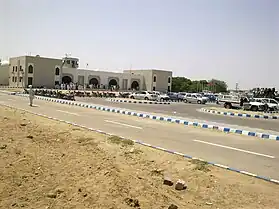Dera Ghazi Khan District
Dera Ghazi Khan (Urdu: ضلع ڈيره غازى خان, Punjabi: ضلع ڈیرا غازی خان , Saraiki: ضلع دیرہ غازی خان, Balochi: ڈیرہ غازی خان دمگ) is a district in the Punjab province of Pakistan. Its capital is the Dera Ghazi Khan city.
Dera Ghazi Khan District
ضلع ڈيره غازى خان ضلع ڈیرا غازی خان ضلع دیرہ غازی خان ڈیرہ غازی خان دمگ | |
|---|---|
 .jpg.webp) Top to bottom: Shrine of Mullah Qaid Shah, Hills of Fort Munro. | |
.png.webp) Map of Dera Ghazi Khan District | |
| Country | |
| Province | |
| Division | Dera Ghazi Khan |
| Headquarters | Dera Ghazi Khan |
| Government | |
| • Type | District Administration |
| • Deputy Commissioner | Sardar Abdullah Dasti |
| • District Police Officer | N/A |
| • District Health Officer | N/A |
| Area | |
| • Total | 11,294 km2 (4,361 sq mi) |
| Population | |
| • Total | 2,872,631 |
| • Density | 250/km2 (660/sq mi) |
| Time zone | UTC+5 (PST) |
| Number of Tehsils | 3 |
| Website | dgkhan |
The district lies to the west of the Indus River. The Sulaiman Mountains rise to a height of 10,000 feet (3,000 m) in the north of the district. Popular tourist destinations are Fort Munro, Yakbai Hill station and Mubarki top.
Administration
The district is divided into three tehsils [3][4] which are divided into a total of sixty Union Councils:[5]
| Tehsil | No. of Unions |
|---|---|
| Dera Ghazi Khan | 41 |
| Kot Chutta | 24 |
| Koh-e-sulaiman | 01 |
Dera Ghazi Khan Tehsil
Dera Ghazi Khan Tehsil, an administrative subdivision of the district. The city of Dera Ghazi Khan is itself administratively subdivided into seven Union Councils.[6]
History
The region around Dera Ghazi Khan was inhabited by Mallian people in late ancient times (500 BC-500 CE) . Then it was part of Multan region in medieval era (500-1500 CE).[7] The town of Dera Ghazi Khan was founded at the close of the 15th century and named after Nawab Ghazi Khan Mirani, son of Nawab Haji Khan Mirani, a Baloch chieftain, the city was founded when Shah Hussain of the Langah Sultanate of Multan invited the Baloch people to settle the region. Together with two other Deras i.e. settlements, Dera Ismail Khan and Dera Fateh Khan, it gave its name to Derajat. Derajat eventually came into the possession of the British after the Sikh War in 1849 and was divided into two districts: Dera Ghazi Khan and Dera Ismail Khan.[8] After the independence, many of the city's Hindu residents settled in Derawal Nagar colony of Delhi, India.[9] The district of Rajanpur was later carved out of the Dera Ghazi Khan district.
Based on the surveys of 2004–2005, Dera Ghazi Khan district is considered one of the 20 poorest districts of Pakistan with about 51% of its population living under the poverty line.[10]

Demographics
At the time of the 2017 census the district had a population of 2,872,631, of which 1,451,327 were males and 1,421,127 females. Rural population is 2,326,410 while the urban population is 546,221. The literacy rate was 46.67%.
Religion
As per the 2017 census, the vast majority of the population was Muslim and made up nearly the entire population with 99.89%.[2]
| Religion | Population (1941)[11]: 42 | Percentage (1941) |
|---|---|---|
| Islam |
512,678 | 88.19% |
| Hinduism |
67,423 | 11.6% |
| Sikhism |
1,072 | 0.18% |
| Christianity |
137 | 0.02% |
| Others [lower-alpha 3] | 40 | 0.01% |
| Total Population | 581,350 | 100% |
Languages
At the time of the 2017 Census of Pakistan, the distribution of the population of Dera Ghazi Khan District by first language was as follows:[12]
Notable people
- Farooq Leghari, former President of Pakistan
- Usman Buzdar, former chief Minister of Punjab
See also
References
- "D.G.Khan | Punjab Portal".
- "District Wise Results / Tables (Census - 2017)". www.pbscensus.gov.pk. Pakistan Bureau of Statistics.
- "Tehsils & Unions in the District of D.G. Khan – Government of Pakistan". Nrb.gov.pk. Archived from the original on 9 February 2012. Retrieved 24 March 2012.
- Pakistan Government – List of Tehsils Archived 5 March 2010 at the Wayback Machine
- Tehsils & Unions in the District of D.G. Khan Archived 9 February 2012 at the Wayback Machine
- "Tehsils & Unions in the District of D.G. Khan – Government of Pakistan". Nrb.gov.pk. Archived from the original on 9 February 2012. Retrieved 24 March 2012.
- Durrani, Ashiq Muhammad Khān (1991). History of Multan: From the Early Period to 1849 A.D. Vanguard. ISBN 978-969-402-045-7.
- Chisholm, Hugh, ed. (1911). . Encyclopædia Britannica. Vol. 8 (11th ed.). Cambridge University Press. p. 64.
- "Colonies, posh and model in name only!". NCR Tribune. Retrieved 16 December 2007.
- Haroon Jamal (June 2007). Income Poverty at District Level: An Application of Small Area Estimation Technique (PDF) (Report). Social Policy and Development Centre. pp. 15–18. Archived from the original (PDF) on 1 February 2014. Retrieved 28 January 2014.
- "CENSUS OF INDIA, 1941 VOLUME VI PUNJAB PROVINCE". Retrieved 22 July 2022.
- Census-2017 - Detailed Tables
- Historic district borders may not be an exact match in the present-day due to various bifurcations to district borders — which since created new districts — throughout the historic Punjab Province region during the post-independence era that have taken into account population increases.
- 1941 census: Including Ad-Dharmis
- Including Jainism, Buddhism, Zoroastrianism, Judaism, or not stated
